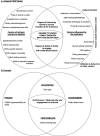Accessibility and Inclusion for Families with Children with Autism Spectrum Disorders in Cultural Institutions
- PMID: 36249990
- PMCID: PMC9540669
- DOI: 10.1111/cura.12468
Accessibility and Inclusion for Families with Children with Autism Spectrum Disorders in Cultural Institutions
Abstract
This project aimed to develop a comprehensive set of evaluation tools to assess the accessibility and inclusion of families with children on the autism spectrum in cultural institutions. A stakeholder team conducted interviews, reviewed museum artifacts, and observed museum programming. An evaluation toolkit was constructed by incorporating best practices from current literature and collected data. Tools were piloted and revised after being implemented in the museum context. The Toolkit to Increase Accessibility and Inclusion for Children on the Autism Spectrum and with Sensory Processing Differences in Cultural Institutions was developed with five unique tools, the Dimensions of Accessibility framework, and further resources to provide a self-assessment of cultural institutions. The toolkit can be used broadly across many types of institutions and self-assessment can lead to proactive development of public spaces, institutions, and programming that is accessible and inclusive of diverse groups of people, beyond families with children on the autism spectrum.
© 2022 The Authors. Curator: The Museum Journal published by Wiley Periodicals LLC.
Figures

Similar articles
-
Delivering allied health services to regional and remote participants on the autism spectrum via video-conferencing technology: lessons learned.Rural Remote Health. 2019 Sep;19(3):5358. doi: 10.22605/RRH5358. Epub 2019 Sep 2. Rural Remote Health. 2019. PMID: 31474113
-
The Economic Impact of Universal Design on Cultural Heritage Contribution to SDGs: Evidence from Italian Museums.Stud Health Technol Inform. 2022 Sep 2;297:491-498. doi: 10.3233/SHTI220878. Stud Health Technol Inform. 2022. PMID: 36073430
-
Virtual Reality (VR) Technology: Empowering Managers to Reduce and Eliminate Accessibility Barriers for People with Autism Spectrum Disorders.Stud Health Technol Inform. 2018;256:253-261. Stud Health Technol Inform. 2018. PMID: 30371482
-
[ADI-R and ADOS and the differential diagnosis of autism spectrum disorders: Interests, limits and openings].Encephale. 2019 Nov;45(5):441-448. doi: 10.1016/j.encep.2019.07.002. Epub 2019 Sep 5. Encephale. 2019. PMID: 31495549 Review. French.
-
A review of screening tools for the identification of autism spectrum disorders and developmental delay in infants and young children: recommendations for use in low- and middle-income countries.Autism Res. 2019 Feb;12(2):176-199. doi: 10.1002/aur.2033. Epub 2019 Feb 1. Autism Res. 2019. PMID: 30707000 Review.
Cited by
-
Application of the Person-Environment-Occupation-Performance Model: A Scoping Review.OTJR (Thorofare N J). 2024 Jul;44(3):521-540. doi: 10.1177/15394492241238951. Epub 2024 Mar 22. OTJR (Thorofare N J). 2024. PMID: 38519867 Free PMC article.
References
-
- American Psychiatric Association (2013). Diagnostic and statistical manual of mental disorders (5th ed.). American Psychiatric Association. 10.1176/appi.books.9780890425596 - DOI
-
- Antonetti, A. , & Fletcher, T. (2016). Parent perceptions of museum participation: A comparison between parents of children with and without autism spectrum disorders. Inclusion, 4(2), 109–119. 10.1352/2326-6988-4.2.109 - DOI
-
- Askari, S. , Anaby, D. , Bergthorson, M. , Majnemer, A. , Elsabbagh, M. , & Zwaigenbaum, L. (2015). Participation of children and youth with autism spectrum disorder: A scoping review. Review Journal of Autism and Developmental Disorders, 2(1), 103–114. 10.1007/s40489-014-0040-7 - DOI
LinkOut - more resources
Full Text Sources
